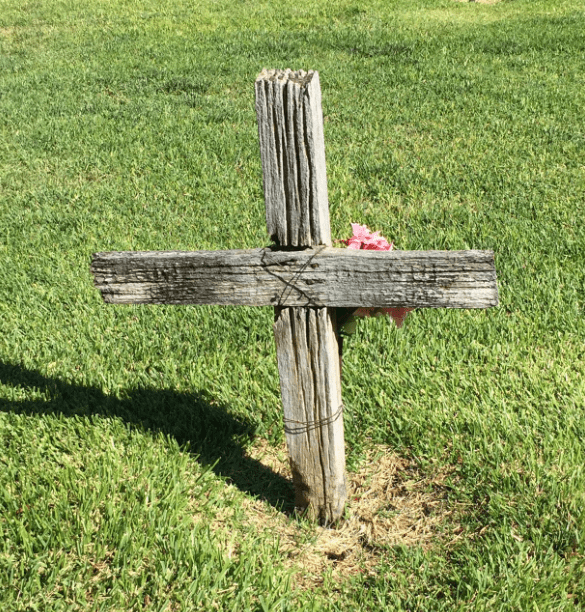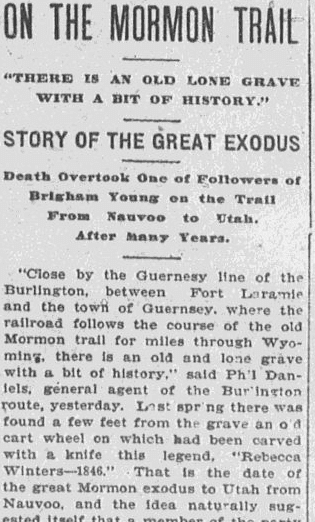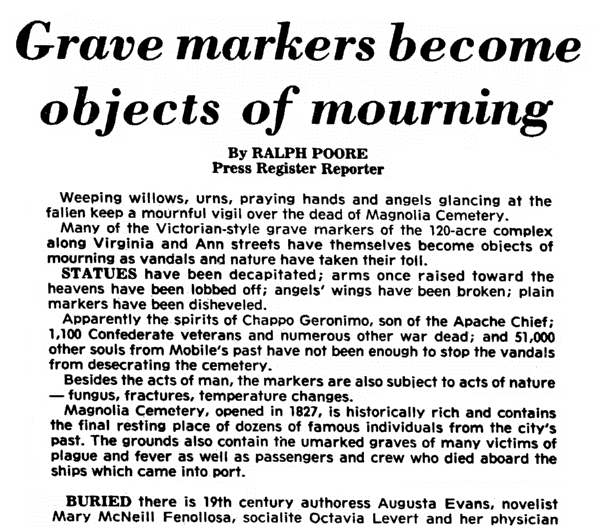Introduction: In this article, Gena Philibert-Ortega shows some steps to take when researching cemeteries to learn more about your ancestors. Gena is a genealogist and author of the book “From the Family Kitchen.”
In addition to government records, historical documents and old newspapers, cemeteries and their accompanying burial records are an important resource for family historians. Here are some genealogy tips to help you research cemeteries to learn more about your ancestors.

Myth: All cemeteries are the same.
Fact: False – there are different types of cemeteries.
If you were to close your eyes and envision a cemetery, what would it look like? Would it be adjacent to an old church? Would it be a long-forgotten cemetery in an overgrown field? Maybe you envision a neatly manicured municipal or national cemetery.
There is not just one kind of cemetery and a city, even a small city, might have several. All cemeteries have a history that begins with whoever began burying people in that particular piece of land, which could have been an individual, family, church, organization, or government entity. A cemetery may have a specific purpose, like the final resting place for soldiers.
Sometimes, burials may not have been planned out – such as in the case of a disaster or epidemic where a mass grave was used. Some cemeteries exist because of historical prejudices, like in the case of ethnic cemeteries. So it’s important to not make assumptions about cemeteries, where they are located, and what records, if any, are kept.
Go beyond online burial websites and research the area where your ancestors lived. Be sure to check the FamilySearch Catalog for cemetery transcriptions. Also, search GenealogyBank’s Historical Newspaper Archives for stories that help you learn more about the history of the cemetery/cemeteries in that area.
Myth: People are always buried where they lived.
Fact: False – start with where your ancestor lived but don’t stop there.
Where do you want to be buried? It may make sense to be buried where you live but that may not be the location where you die. Illness or the need for long-term care may mean a move to be closer to family. Dying on vacation or while living with family members may mean a change in plans for a final resting place. A family plot may be purchased only to be sold, go unused, or given to non-family members. It may be someone’s wish to be buried with their family who are interred in another state.
What about those who are cremated? No marker may exist for them especially if their remains are scattered or stored in someone’s home. So finding the burial place of an ancestor may involve expanding your research outside of the city where the person lived.

Myth: People are always buried next to family members.
Fact: False – while we would like to think that, it doesn’t always happen.
One of my paternal 2nd great-grandmothers is buried in a cemetery far away from the burials of her husband and children. The reason why is actually answered by knowing some history. She died during the World War II years when gasoline was rationed. She was living in Oregon, her husband pre-deceased her in Colorado, and most of her family was living in other states.
When she died, out-of-state family members did not have access to enough gasoline to travel to the funeral. Even those who lived in-state were an hour away and most likely would not have had enough gas rations to make the trip. Her single gravestone, surrounded by non-relatives, is in a cemetery near where she died.
Sometimes where a person is buried is influenced by finances, family resources, and even history. Arrangements for the burial of our ancestors, just as in today’s world, were influenced by numerous factors that need to be considered when we search for an ancestor’s burial.
This 1902 newspaper article reports on the discovery of the grave of Rebecca Winters. The article says she was “…a member of the party of 500 persons who accompanied Brigham Young” in 1846 during “the great Mormon exodus to Utah from Nauvoo [Illinois].” One might expect to find Winters’ grave in Salt Lake City, but she died during that journey and was buried where she fell in Wyoming.

Myth: All cemeteries have records.
Fact: False – there are different types of cemeteries and they may or may not have records.
Remember Myth #1 that all cemeteries are the same? That myth pretty much answers this question about records. While some cemeteries keep great records, for example many city cemeteries, small family cemeteries or abandoned cemeteries may leave behind no records at all. And even when the cemetery is a city cemetery, their records may not include everyone buried there.
In one case, a cemetery where I know my ancestor is buried (confirmed by the obituary and death certificate) had no records before the middle of the 20th century because of an office fire. They also never tried to recreate those records, and told me that there was no reason to since those people and their descendants were dead. Record keeping may not always be a priority for some cemeteries. That’s why looking for other death records like an obituary or funeral notice in the newspaper, a death certificate, or church record is so important.
Myth: All graves are marked.
Fact: False.
Not everyone’s grave is marked, and once again it can be because of a lack of money – as in the case of one of the women I’m currently researching who had no spouse or children when she died. Her parents and brother pre-deceased her. Luckily for her a close friend made sure she was buried by her family, but the friend wasn’t able to purchase a headstone. Without a headstone, websites that provide photos or a listing of burials don’t have her listed. It was by calling the cemetery that I found out she was buried with her family, the only burial in the family plot that wasn’t marked.

Other reasons someone may rest in an unmarked grave? Vandals and those who steal metal from markers to recycle often cause problems for cemeteries. Wood markers can deteriorate over time leaving a dry, mangled unreadable stick. Those who died without funds may be buried in an unmarked pauper’s grave, or their ashes may be kept in an unmarked common vault.

Myth: Cemeteries don’t disappear.
Fact: False – cemeteries, like towns, can and do disappear.
Cemeteries disappear over time for all kinds of reasons. The elements may take over and cover tombstones with foliage. Cities are flooded to create dams, leaving burials resting under 100 feet or more of water. While some towns’ graves are moved – as in the case of St. Thomas, Nevada, which was flooded to create Lake Mead – this doesn’t always happen.
It’s not unusual for a city to decide that an existing cemetery is the perfect place for a new park or other development, and therefore order the bodies to be moved and the cemetery closed. This official notice from a 1924 newspaper concerns a case in San Francisco, California, in which the Board of Supervisors decided that the real estate of the growing city was too valuable to remain the resting place of the dead – so burials were relocated to Colma, California.
Note that in the title of the ordinance, the given rationale for disinterring the bodies is because maintenance of the existing cemetery “threatens and endangers the health, safety, comfort and welfare of the public.”

Older cemeteries can be abandoned and fall prey to the elements. In other cases, “progress” plows right over the cemetery and covers it with a road, homes, or a building. Chances are that if you’re researching an older town there could have been other cemeteries that don’t appear to exist today.
Do You Know Cemeteries?
Cemeteries are not all the same and we can easily believe that we’ve seen everything. It’s important to do your homework when traveling to a cemetery. Seek out the history of burials in the area and look through old transcriptions, which are vital in cases where markers have been removed or damaged. Don’t stop at just searching on your ancestor’s name – really study the area to help you better understand where your ancestor could be buried.
Related Articles:

Hi,
My name is Bernadette Carty. I am writing this email from the Republic of Ireland. My late Grandfather Owen A. McCarthy died in the Montana State Hospital on the 14th of March 1953. His Death Certificate states that he was to be interred in Mount Olivet Cemetery in Anaconda, and his Obituary says he was buried in Mount Carmel Cemetery in Anaconda. It now turns out there are no records for him in either of these cemeteries.
I have checked the cemeteries attached to the Montana State Hospital also and he is not buried in the cemetery there.
I have spent endless hours searching “Find a Grave” and “Billion Graves” but getting nowhere.
Can you advise where I might go to from here. I would appreciate any help.
Regards,
Bernadette Carty
Bernadette, Did you contact the cemeteries or did you look online? Someone could be buried without a headstone in which case they wouldn’t be listed in an online cemetery website where volunteers are documenting headstones.
Does his death certificate list a funeral home? Do they still exist and if so, have you contacted them about their records?
Where is his family (spouse or children) buried? Did you check there?
Did he have family to pay for the burial? If he didn’t he would have been buried at the hospital, a paupers grave in a nearby cemetery, or his body could have been denoted to science.
Does he have an obituary?
Gena,
I have done all of the above, I have narrowed it down to a particular section of Mount Carmel Cemetery in Anaconda, Montana.
From looking at the map and a satellite map of the cemetery this section looks to be very unkept.
It does not look as if there are a lot of graves. I have tried to get a list of plots for this section on Family Search.org but for some reason they are not available.
The Cemetery Director tells me that these are random graves in an open area and to find this grave by a process of elimination would not be possible. It is looking more and more like a pauper’s plot, but I would have thought that once a grave is opened it must be recorded somewhere.
I don’t know where to go from here. I would appreciate any advice you can give me please.
Bernadette,
Records, especially older cemetery records, aren’t always extant. And in some cases for those who are in pauper’s graves they just may not have noted anything.
Is there any historical records for this cemetery (like annual reports) in a nearby archive? I wonder if that would provide some clues. It might also help to talk to someone who was involved with the community at that time or shortly thereafter who might know what happened with these burials. You need to know more about the process in burying paupers. Have you contacted the local historical society?